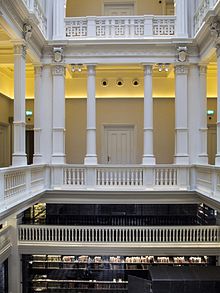SALT (institution)
 Interior of SALT Galata | |
 | |
| Established | 2011 |
|---|---|
| Location | SALT Beyoğlu Istiklal Cd. No:136 Beyoğlu, Istanbul Turkey SALT Galata Bankalar Cd. No:11 Karaköy, Istanbul Turkey |
| Founder | Vasif Kortun, Garanti Bank |
| Website | saltonline |
SALT is a Turkish contemporary art institution. It was started by Vasif Kortun and Garanti Bank in 2011, and has exhibition and workshop spaces in Istanbul and Ankara, Turkey.[1][2] It combines the previous activities of the Garanti Gallery, the Ottoman Bank Archives and Research Centre and the Platform Garanti Contemporary Art Center of the bank.[3] It is one of the six members of L'Internationale, a confederation of European art institutions; the other member institutions are the Moderna galerija in Ljubljana, in Slovenia; the Museo Nacional Centro de Arte Reina Sofía in Madrid, in Spain; the Museu d'Art Contemporani de Barcelona in Barcelona, also in Spain; the Museum van Hedendaagse Kunst Antwerpen in Antwerp, in Belgium; and the Van Abbemuseum in Eindhoven, in the Netherlands.[4]
It is also a member of ALANA (Art Libraries and Archives Networks Asia).[5]
Gallery spaces[]

SALT has three gallery spaces, all owned by Garanti Bank: the former headquarters of the Imperial Ottoman Bank in Galata, Istanbul;[1] a former apartment block, the Siniossoglou Apartments, in Beyoğlu, Istanbul;[3] and a former guest-house of the Ottoman Bank in Ulus, Ankara.[6]
Library[]
SALT Research comprises a specialized library and an archive of physical and digital sources and documents on visual practices, the built environment, social life and economic history. Collections at SALT Research focus on the period from the late 19th century to the present day with an emphasis on Turkey -primarily Istanbul- and the geographies of the Southeast Mediterranean and Southeast Europe. The collections include visual and textual sources and documents on the art history of Turkey post 1950, the development of architecture and design in Turkey since the beginning of the 20th century, and the transformations in society and the region from the last century of the Ottoman Empire to the Turkish Republic up until the 1990s.
References[]
- ^ a b Suzy Hansen (10 February 2012). The Istanbul Art-Boom Bubble The New York Times. Accessed May 2016.
- ^ Art boom: Greater importance is being placed on arts and culture. In: The Report: Turkey 2012. Oxford: Oxford Business Group. Accessed May 2016.
- ^ a b [s.n.] (8 April 2011) Garanti Bank's SALT sets out to become Turkey's biggest cultural institute. Today's Zaman. Archived 20 October 2014.
- ^ Confederation – L'Internationale. L'Internationale. Accessed May 2016.
- ^ [1]. ALANA.
- ^ Erkan Aktug (4 April 2013). Ankara'nın da Salt'ı var (in Turkish). Radikal. Accessed April 2017.
- Art museums and galleries in Istanbul
- Museums in Istanbul
- Libraries in Turkey
- Buildings and structures in Istanbul
- Art museums established in 2011
- 2011 establishments in Turkey